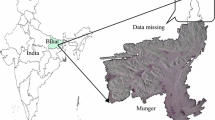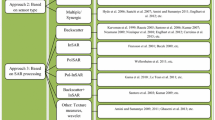Abstract
Optical remote sensing data have been extensively used to derive biophysical properties that relate forest type and composition. However, stand density, stand height and stand volume cannot be estimated directly from optical remote sensing data owing to poor sensitivity between these parameters and spectral reflectance. The ability of microwave energy to penetrate within forest vegetation makes it possible to extract information on both the crown and trunk components from radar data. The type of polarization employed determines the radar response to the various shapes and orientations of the scattering mechanisms within the canopy or trunk. This study mainly presents experimental results obtained with airborne E-SAR using polarimetric C and L bands over the tropical dry deciduous forest of Chandrapur Forest Division, Maharashtra. A detailed documentation of the relationship between SAR C & L bands backscattering and forest stand variables has been provided in the present study through linear correlation. Linear correlation of the single channel SAR derived estimates with the field measured means show a good correlation between L HV backscattering coefficient with stand volume (r2 = 0.71) and L HH backscattering coefficient with stand density (r2 = 0.75). The results imply that SAR data has significant potential for stand menstruation in operational forestry.






Similar content being viewed by others
References
Champion, H. G., & Seth, S. K. (1968). A revised survey of the forests types of India. New Delhi: Manager of Publications. 404.
Dobson, M. C., Ulaby, F. T., Pierce, L. E., Sharik, T. L., Bergen, K. M., & Kellndorfer, J. (1995). Estimation of forest biophysical characteristics in Northern Michigan with SIR-C/X-SAR. IEEE, Transactions on Geosciencse and Remote Sensing, 33(4), 877–894.
Ferrazoli, P., & Guerriero, L. (1995). Radar sensitivity to tree geometry and woody volume: a model analysis. IEEE, Transactions on Geosciencse and Remote Sensing, 33, 360–371.
Hans, I., Ulander, L. M. H., Askne, J. I. H., Fransson, J. E. S., & Frolind, P.-O. (1997). Retrieval of forest stem volume using VHF SAR. IEEE, Transactions on Geosciencse and Remote Sensing, 35(1), 36–40.
Imhoff, M. L. (1993). Radar backscatter/biomass saturation: Observations and implications for global biomass assessment. Proc. of the International Geoscience and Remote Sensing symposium held at Tokyo, Japan from August 18–21, 1993, pp 43–45.
Johan, E. S., Fransson, F. W., & Ulander, L. M. H. (2000). Estimation of forest parameters using CARABAS-II VHF SAR data. IEEE Transactions on Geosciencse and Remote Sensing, 38(2), 720–727.
Lopez-Sanchez, J. M., Ballester-Berman, J. D., & Fortuny-Guasch, J. (2006). Indoor wide-band polarimetric measurements on Maize plants: A study of the differential extinction coefficient. IEEE, Transactions on Geosciencse and Remote Sensing, 44, 758–767.
Patel, P., Srivastava, H. S., Panigrahy, S., & Parihar, J. S. (2006). A Comparative evaluation of sensitivity of multi-polarized multi-frequency SAR backscatter to plant density. International Journal of Remote Sensing, 27(2), 293–305.
Shakil, A. R., & Masanobu, S. (2001) Employing SAR for retrieval from tropical forests of Southeast Asia. Proc. of the 22nd Asian Conference on Remote sensing, held at Singapore from November. 5–9, 2001, pp 65–72.
Srivastava, H. S., Parul, P., Sharma, Y., & Navalgund, R. R. (2007). Use of SAR interferometry for delineation and density mapping of forested areas. International Journal of Geoinformatics—Forestry Special Issue, 3(.2), 01–10.
Vyjayanthi, N., Jha, C. S., & Rangaswamy, M. (2010). Estimation of above ground biomass in Indian tropical forested area using multi-frequency DLR ESAR data. International Journal of Geomatics and Geosciences, 1(2), 167–177.
Acknowledgements
We place our sincere thanks to V. Jayaraman, Director, NRSC, Hyderabad for his constant encouragement and valuable suggestions throughout the study. We are extremely thankful to Ranganath Navalgund,. Director Sapce Application Center, Ahemadabad and, K.L. Majumdar, Chairman, project management board, JEP-MW, Space Application Center, for entrusting this study to RRSSC, Nagpur and providing the necessary funds. We are thankful to Manab Chakraborthy, Group director, GTDG/RESIPA & project director, JEP-MW, for his guidance; Shiv Mohan, Head ATDD/GTDG/RESIPA, and Vikas Patil, Project Manager, JEP-MW for their keen interest and constant encouragement during the course of the study.
Author information
Authors and Affiliations
Corresponding author
About this article
Cite this article
Alappat, V.O., Joshi, A.K. & Krishnamurthy, Y.V.N. Tropical Dry Deciduous Forest Stand Variable Estimation Using SAR Data. J Indian Soc Remote Sens 39, 583–589 (2011). https://doi.org/10.1007/s12524-011-0118-y
Received:
Accepted:
Published:
Issue Date:
DOI: https://doi.org/10.1007/s12524-011-0118-y




